2013+内分泌学会临床指南:多囊卵巢综合征的诊断和治疗
- 格式:pdf
- 大小:331.85 KB
- 文档页数:29

简述多囊卵巢综合征的诊断标准
多囊卵巢综合征(PCOS)是一种常见的内分泌系统疾病,其中卵巢中存在多个囊状卵泡,导致女性月经不调、不孕等问题。
为了确诊PCOS,医生通常需要根据以下三个标准进行诊断:
1.临床表现标准:
女性必须满足两个或以上以下标准:月经不规律或缺失;高雄体质指数(BMI);多毛或男性化特征(如面部、胸部、腹部、肢体的多毛、声音低沉等)。
2.超声检查标准:
卵巢中应具有12个或以上的囊状卵泡,每个卵巢的大小应大于10毫升。
3.内分泌标准:
应测量血液中的性激素和代谢物质水平,包括高睾酮、高LH/FSH 比例和高胰岛素。
如果女性满足上述三项标准中的两项或以上,就可以被诊断为PCOS。
这种疾病需要及时治疗,以避免进一步的健康问题。
- 1 -。
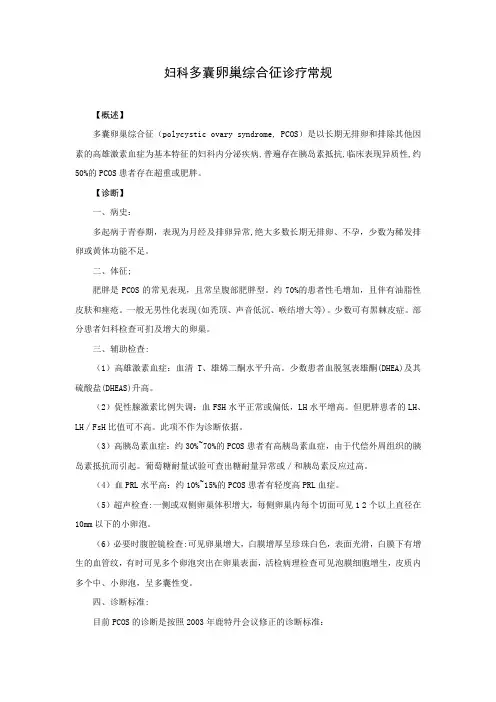
妇科多囊卵巢综合征诊疗常规【概述】多囊卵巢综合征(polycystic ovary syndrome, PCOS)是以长期无排卵和排除其他因素的高雄激素血症为基本特征的妇科内分泌疾病,普遍存在胰岛素抵抗,临床表现异质性,约50%的PCOS患者存在超重或肥胖。
【诊断】一、病史:多起病于青春期,表现为月经及排卵异常,绝大多数长期无排卵、不孕,少数为稀发排卵或黄体功能不足。
二、体征;肥胖是PCOS的常见表现,且常呈腹部肥胖型。
约70%的患者性毛增加,且伴有油脂性皮肤和痤疮。
一般无男性化表现(如秃顶、声音低沉、喉结增大等)。
少数可有黑棘皮症。
部分患者妇科检查可扪及增大的卵巢。
三、辅助检查:(1)高雄激素血症:血清T、雄烯二酮水平升高。
少数患者血脱氢表雄酮(DHEA)及其硫酸盐(DHEAS)升高。
(2)促性腺激素比例失调:血FSH水平正常或偏低,LH水平增高。
但肥胖患者的LH、LH/FsH比值可不高。
此项不作为诊断依据。
(3)高胰岛素血症:约30%~70%的PCOS患者有高胰岛素血症,由于代偿外周组织的胰岛素抵抗而引起。
葡萄糖耐量试验可查出糖耐量异常或/和胰岛素反应过高。
(4)血PRL水平高:约10%~15%的PCOS患者有轻度高PRL血症。
(5)超声检查:一侧或双侧卵巢体积增大,每侧卵巢内每个切面可见1 2个以上直径在10mm以下的小卵泡。
(6)必要时腹腔镜检查:可见卵巢增大,白膜增厚呈珍珠白色,表面光滑,白膜下有增生的血管纹,有时可见多个卵泡突出在卵巢表面,活检病理检查可见泡膜细胞增生,皮质内多个中、小卵泡,呈多囊性变。
四、诊断标准:目前PCOS的诊断是按照2003年鹿特丹会议修正的诊断标准:①稀发排卵或无排卵;②高雄激素的临床和/或生物化学征象;③多囊卵巢超声提示卵巢体积≥10ml,或同一个切面上直径2~9mm的卵泡数≥12个;以上三项中具备二项,并排除其它病因(先天性肾上腺皮质增生、柯兴氏综合征、分泌雄激素的肿瘤)即可诊断。
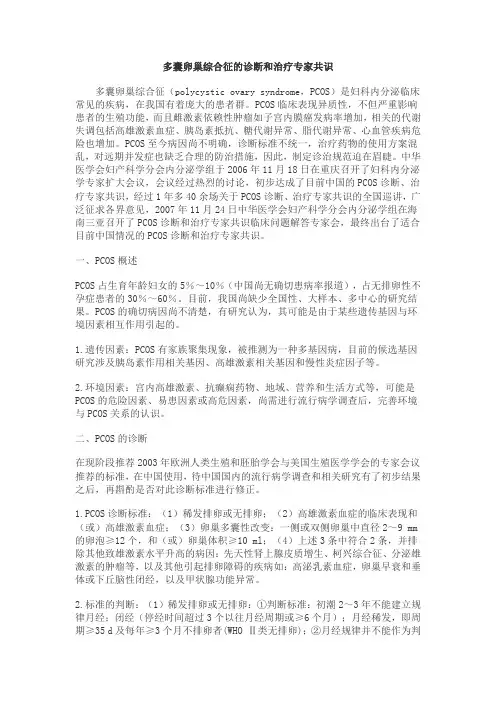
多囊卵巢综合征的诊断和治疗专家共识多囊卵巢综合征(polycystic ovary syndrome,PCOS)是妇科内分泌临床常见的疾病,在我国有着庞大的患者群。
PCOS临床表现异质性,不但严重影响患者的生殖功能,而且雌激素依赖性肿瘤如子宫内膜癌发病率增加,相关的代谢失调包括高雄激素血症、胰岛素抵抗、糖代谢异常、脂代谢异常、心血管疾病危险也增加。
PCOS至今病因尚不明确,诊断标准不统一,治疗药物的使用方案混乱,对远期并发症也缺乏合理的防治措施,因此,制定诊治规范迫在眉睫。
中华医学会妇产科学分会内分泌学组于2006年11月18日在重庆召开了妇科内分泌学专家扩大会议,会议经过热烈的讨论,初步达成了目前中国的PCOS诊断、治疗专家共识,经过1年多40余场关于PCOS诊断、治疗专家共识的全国巡讲,广泛征求各界意见,2007年11月24日中华医学会妇产科学分会内分泌学组在海南三亚召开了PCOS诊断和治疗专家共识临床问题解答专家会,最终出台了适合目前中国情况的PCOS诊断和治疗专家共识。
一、PCOS概述PCOS占生育年龄妇女的5%~10%(中国尚无确切患病率报道),占无排卵性不孕症患者的30%~60%。
目前,我国尚缺少全国性、大样本、多中心的研究结果。
PCOS的确切病因尚不清楚,有研究认为,其可能是由于某些遗传基因与环境因素相互作用引起的。
1.遗传因素:PCOS有家族聚集现象,被推测为一种多基因病,目前的候选基因研究涉及胰岛素作用相关基因、高雄激素相关基因和慢性炎症因子等。
2.环境因素:宫内高雄激素、抗癫痫药物、地域、营养和生活方式等,可能是PCOS的危险因素、易患因素或高危因素,尚需进行流行病学调查后,完善环境与PCOS关系的认识。
二、PCOS的诊断在现阶段推荐2003年欧洲人类生殖和胚胎学会与美国生殖医学学会的专家会议推荐的标准,在中国使用,待中国国内的流行病学调查和相关研究有了初步结果之后,再斟酌是否对此诊断标准进行修正。
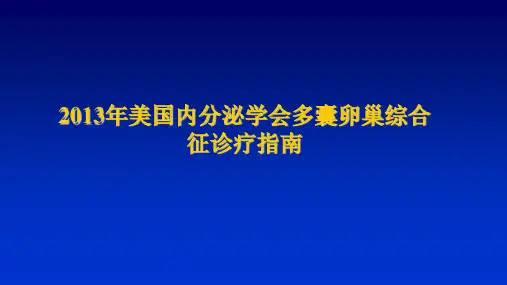
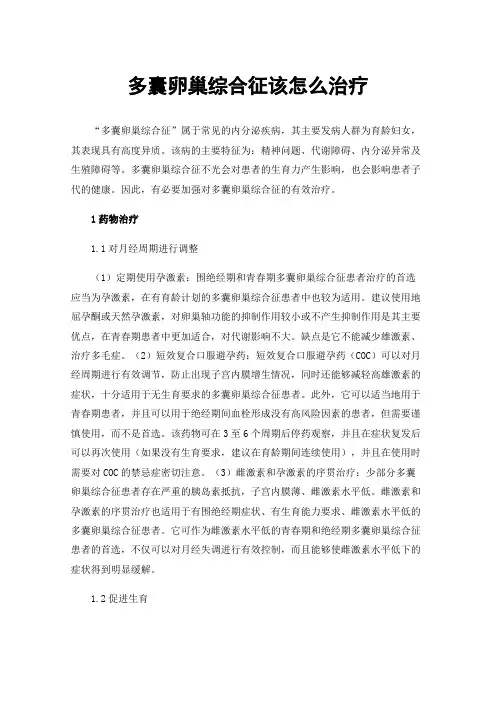
多囊卵巢综合征该怎么治疗“多囊卵巢综合征”属于常见的内分泌疾病,其主要发病人群为育龄妇女,其表现具有高度异质。
该病的主要特征为:精神问题、代谢障碍、内分泌异常及生殖障碍等。
多囊卵巢综合征不光会对患者的生育力产生影响,也会影响患者子代的健康。
因此,有必要加强对多囊卵巢综合征的有效治疗。
1药物治疗1.1对月经周期进行调整(1)定期使用孕激素:围绝经期和青春期多囊卵巢综合征患者治疗的首选应当为孕激素,在有育龄计划的多囊卵巢综合征患者中也较为适用。
建议使用地屈孕酮或天然孕激素,对卵巢轴功能的抑制作用较小或不产生抑制作用是其主要优点,在青春期患者中更加适合,对代谢影响不大。
缺点是它不能减少雄激素、治疗多毛症。
(2)短效复合口服避孕药:短效复合口服避孕药(COC)可以对月经周期进行有效调节,防止出现子宫内膜增生情况,同时还能够减轻高雄激素的症状,十分适用于无生育要求的多囊卵巢综合征患者。
此外,它可以适当地用于青春期患者,并且可以用于绝经期间血栓形成没有高风险因素的患者,但需要谨慎使用,而不是首选。
该药物可在3至6个周期后停药观察,并且在症状复发后可以再次使用(如果没有生育要求,建议在育龄期间连续使用),并且在使用时需要对COC的禁忌症密切注意。
(3)雌激素和孕激素的序贯治疗:少部分多囊卵巢综合征患者存在严重的胰岛素抵抗,子宫内膜薄、雌激素水平低。
雌激素和孕激素的序贯治疗也适用于有围绝经期症状、有生育能力要求、雌激素水平低的多囊卵巢综合征患者。
它可作为雌激素水平低的青春期和绝经期多囊卵巢综合征患者的首选,不仅可以对月经失调进行有效控制,而且能够使雌激素水平低下的症状得到明显缓解。
1.2促进生育(1)孕前咨询:对于多囊卵巢综合征的不孕患者,在提倡生育治疗之前,应检查夫妻双方,以将可能导致生殖失败的危险因素确认并设法纠正,例如高血压、糖尿病、不受控制的糖耐量降低、肥胖等。
具体措施包括控制血压和血糖、戒烟戒酒、减肥等,并指出促进肥胖和不育多囊卵巢综合征患者生育的基本治疗方法是减肥。
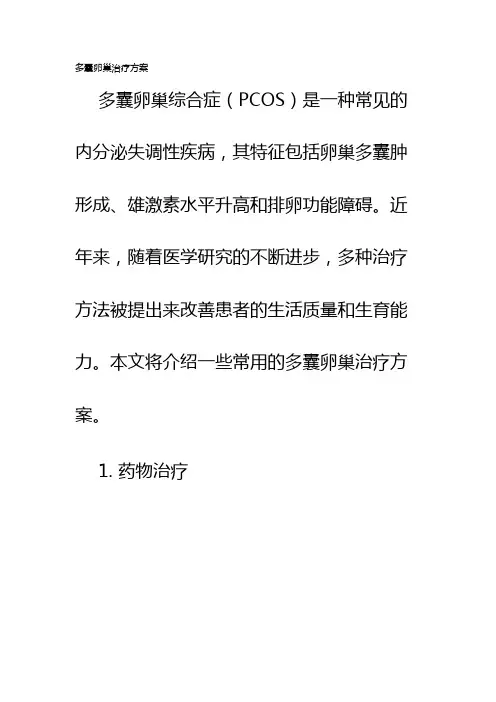
多囊卵巢治疗方案多囊卵巢综合症(PCOS)是一种常见的内分泌失调性疾病,其特征包括卵巢多囊肿形成、雄激素水平升高和排卵功能障碍。
近年来,随着医学研究的不断进步,多种治疗方法被提出来改善患者的生活质量和生育能力。
本文将介绍一些常用的多囊卵巢治疗方案。
1. 药物治疗药物治疗是目前多囊卵巢综合症的主要治疗方法之一。
常用的药物包括口服避孕药、胰岛素增敏剂和抗雄激素药物等。
(1)口服避孕药:口服避孕药可抑制卵巢的雄激素分泌,帮助调节月经周期和减轻多囊卵巢综合症的症状。
具体使用方法需根据医生指导进行。
(2)胰岛素增敏剂:胰岛素增敏剂通过提高细胞对胰岛素的敏感性,可以改善胰岛素抵抗和血糖控制,减少多囊卵巢综合症患者的胰岛素水平。
(3)抗雄激素药物:抗雄激素药物可以抑制卵巢的雄激素的合成和分泌,帮助恢复卵巢的正常功能和平衡雄激素水平。
2. 营养调理良好的饮食习惯和适当的减肥可以帮助改善多囊卵巢综合症的症状和恢复排卵功能。
(1)低GI食物:选择低GI(血糖指数)食物,可以减缓血糖的上升速度,减少胰岛素的分泌,改善胰岛素抵抗。
(2)减少饱和脂肪摄入:高饱和脂肪摄入与多囊卵巢综合症的发病率和症状的严重程度有关。
减少动物脂肪的摄入,增加富含Omega-3脂肪酸的食物的摄入,对改善病情有益。
(3)均衡膳食:保证每餐都包含蛋白质、脂肪和碳水化合物的合理比例,避免单一饮食的偏食,保证营养的均衡。
3. 生活方式管理合理的生活方式管理可以有效地改善多囊卵巢综合症的症状,提高生活质量。
(1)适量运动:适量的运动可以帮助减轻体重、改善胰岛素敏感性和调节激素水平。
建议每周至少进行150分钟的有氧运动。
(2)定期检查:定期进行妇科检查,包括超声检查和激素水平检测,监测卵巢功能和疾病进展。
(3)压力管理:多囊卵巢综合症患者常伴有焦虑和抑郁等心理问题,合理的心理调节和减压方法可以帮助改善心理状态和症状。
总结:多囊卵巢治疗方案包括药物治疗、营养调理和生活方式管理。
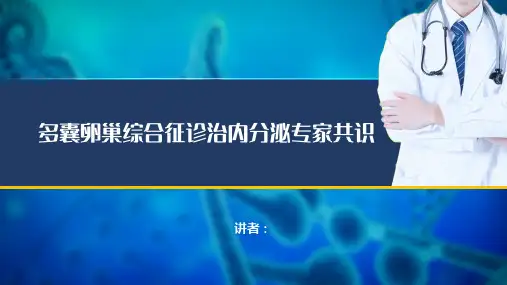

多囊卵巢综合征的诊断和治疗多囊卵巢综合征是生育年龄妇女最常见的内分泌疾病,发病率约4%~12%,具有代谢紊乱、肥胖、不孕等影响,甚至引发子宫内膜癌、糖尿病等严重疾病。
为此,探究多囊卵巢综合征的诊断以及治疗手段显得尤为重要。
因此,本文基于多囊卵巢综合征的诊断标准,从稀发排卵及不排卵、基础体温等方面阐述其判断标准,并且介绍诊断思路,然后从生活方式的调整、调整月经周期、促排卵治疗等措施着手治疗多囊卵巢综合征,最后简述性激素的意义。
标签:多囊卵巢;诊断;治疗1 多囊卵巢综合征的诊断1.1 多囊卵巢综合征的诊断标准①稀发排卵及不排卵;②高雄激素血症(临床和(或)生化表现);③超声显示卵巢多囊性改变。
以上三条中符合其中两条。
同时并排除其它致雄激素水平升高的病因及其它引起排卵障碍的疾病及甲状腺功能异常[1]。
1.2 标准的判断稀发排卵及不排卵:①初潮2~3年后不能建立规律的月经;闭经(停经时间超过3个周期或≥6个月);月经稀发,即周期≥35天及每年≥3个月不排卵者。
②月经规律不能作为判断有排卵的证据;③基础体温,B超监测排卵,月经后半期监测孕酮等方法有助于判断是否排卵。
雄激素水平增高的临床表现:痤疮、多毛[2]。
雄激素水平升高的生化指标:总睾酮,游离睾酮指数或游离睾酮指数水平高于实验室正常参考值。
多囊卵巢诊断标准:一侧或双侧卵巢中直径2~9mm的卵泡≥12个和(或)卵巢体积≥10ml。
1.3 多囊卵巢综合征的诊断思路患者主诉多毛发生长,先进行病史采集及体格检查,排除正常改变及超多毛症后确定为多毛症,需检查男性化体征(男性化临床特征有:多毛、痤疮、黑棘皮症)。
有男性化体征,再进行全面的激素分析(包括脱氢表雄酮、睾酮、17羟孕酮)及影像学检查、必要时手术探查:无男性化体征,询问月经史,月经正常查血清孕酮及17-羟孕酮,血清睾酮≤200ng/dl,为排卵停止;血清睾酮≥200ng/dl 盆腔检查正常或触及附件包块、影像学检查、必要时手术探查。
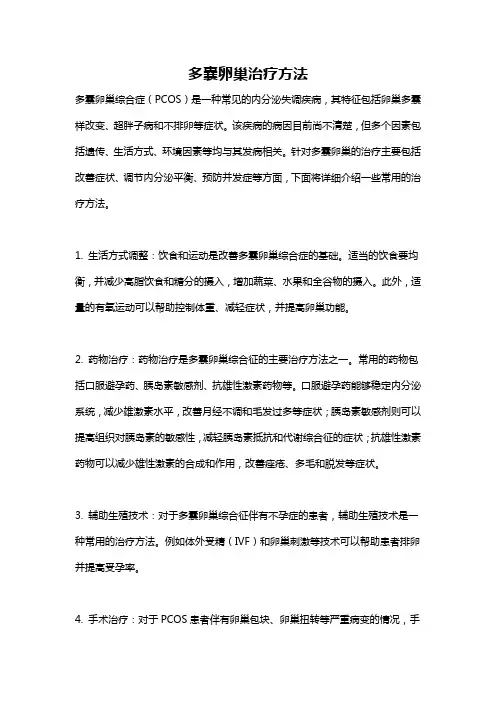
多囊卵巢治疗方法多囊卵巢综合症(PCOS)是一种常见的内分泌失调疾病,其特征包括卵巢多囊样改变、超胖子病和不排卵等症状。
该疾病的病因目前尚不清楚,但多个因素包括遗传、生活方式、环境因素等均与其发病相关。
针对多囊卵巢的治疗主要包括改善症状、调节内分泌平衡、预防并发症等方面,下面将详细介绍一些常用的治疗方法。
1. 生活方式调整:饮食和运动是改善多囊卵巢综合症的基础。
适当的饮食要均衡,并减少高脂饮食和糖分的摄入,增加蔬菜、水果和全谷物的摄入。
此外,适量的有氧运动可以帮助控制体重、减轻症状,并提高卵巢功能。
2. 药物治疗:药物治疗是多囊卵巢综合征的主要治疗方法之一。
常用的药物包括口服避孕药、胰岛素敏感剂、抗雄性激素药物等。
口服避孕药能够稳定内分泌系统,减少雄激素水平,改善月经不调和毛发过多等症状;胰岛素敏感剂则可以提高组织对胰岛素的敏感性,减轻胰岛素抵抗和代谢综合征的症状;抗雄性激素药物可以减少雄性激素的合成和作用,改善痤疮、多毛和脱发等症状。
3. 辅助生殖技术:对于多囊卵巢综合征伴有不孕症的患者,辅助生殖技术是一种常用的治疗方法。
例如体外受精(IVF)和卵巢刺激等技术可以帮助患者排卵并提高受孕率。
4. 手术治疗:对于PCOS患者伴有卵巢包块、卵巢扭转等严重病变的情况,手术可能是必要的治疗方法。
手术可通过切除卵巢包块或卵巢囊肿等方式,减轻症状和恢复卵巢功能。
5. 中医药治疗:中医药治疗多囊卵巢综合征在一定程度上可以改善症状和调节内分泌系统。
中医药可以根据个体情况进行辨证施治,包括中药汤剂、针灸、艾灸等,以调理脏腑功能,改善症状。
总之,多囊卵巢综合征的治疗方法多样,选择治疗方法应根据患者的具体情况和治疗目标进行综合评估。
饮食和运动是最基本的改善方法,药物治疗和辅助生殖技术可以在医生的指导下使用,中医药治疗则可能是一种综合调控内分泌的辅助治疗方法。
在接受治疗过程中,患者需要与医生保持紧密的沟通,定期复查并遵守医生指导,以达到最佳的治疗效果。
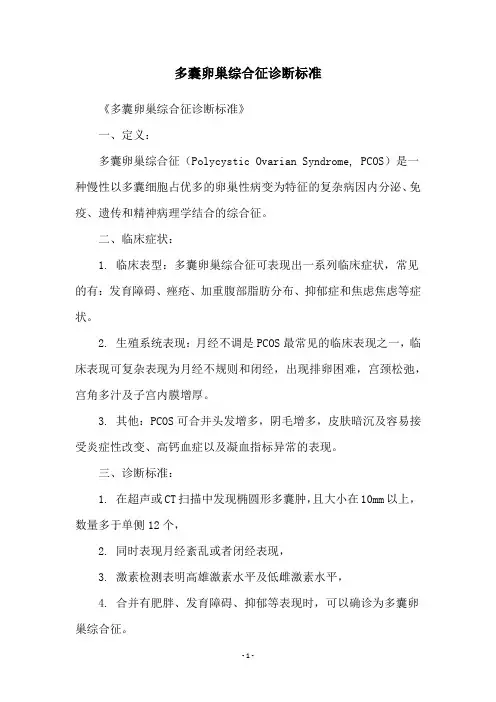
多囊卵巢综合征诊断标准
《多囊卵巢综合征诊断标准》
一、定义:
多囊卵巢综合征(Polycystic Ovarian Syndrome, PCOS)是一种慢性以多囊细胞占优多的卵巢性病变为特征的复杂病因内分泌、免疫、遗传和精神病理学结合的综合征。
二、临床症状:
1. 临床表型:多囊卵巢综合征可表现出一系列临床症状,常见的有:发育障碍、痤疮、加重腹部脂肪分布、抑郁症和焦虑焦虑等症状。
2. 生殖系统表现:月经不调是PCOS最常见的临床表现之一,临床表现可复杂表现为月经不规则和闭经,出现排卵困难,宫颈松弛,宫角多汁及子宫内膜增厚。
3. 其他:PCOS可合并头发增多,阴毛增多,皮肤暗沉及容易接受炎症性改变、高钙血症以及凝血指标异常的表现。
三、诊断标准:
1. 在超声或CT扫描中发现椭圆形多囊肿,且大小在10mm以上,数量多于单侧12个,
2. 同时表现月经紊乱或者闭经表现,
3. 激素检测表明高雄激素水平及低雌激素水平,
4. 合并有肥胖、发育障碍、抑郁等表现时,可以确诊为多囊卵巢综合征。
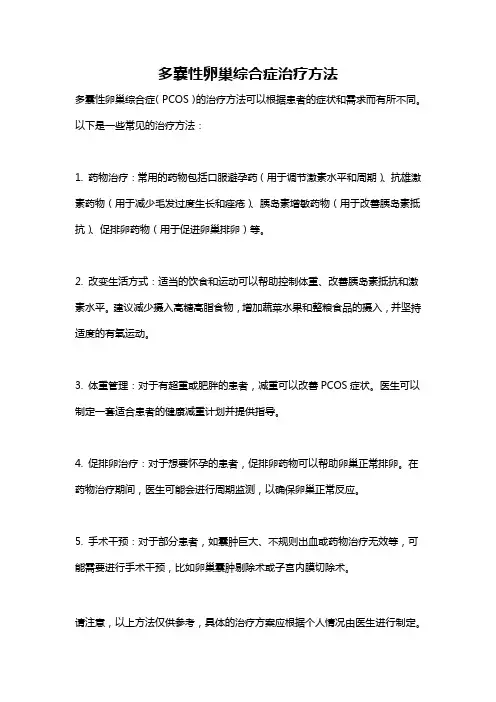
多囊性卵巢综合症治疗方法
多囊性卵巢综合症(PCOS)的治疗方法可以根据患者的症状和需求而有所不同。
以下是一些常见的治疗方法:
1. 药物治疗:常用的药物包括口服避孕药(用于调节激素水平和周期)、抗雄激素药物(用于减少毛发过度生长和痤疮)、胰岛素增敏药物(用于改善胰岛素抵抗)、促排卵药物(用于促进卵巢排卵)等。
2. 改变生活方式:适当的饮食和运动可以帮助控制体重、改善胰岛素抵抗和激素水平。
建议减少摄入高糖高脂食物,增加蔬菜水果和整粮食品的摄入,并坚持适度的有氧运动。
3. 体重管理:对于有超重或肥胖的患者,减重可以改善PCOS症状。
医生可以制定一套适合患者的健康减重计划并提供指导。
4. 促排卵治疗:对于想要怀孕的患者,促排卵药物可以帮助卵巢正常排卵。
在药物治疗期间,医生可能会进行周期监测,以确保卵巢正常反应。
5. 手术干预:对于部分患者,如囊肿巨大、不规则出血或药物治疗无效等,可能需要进行手术干预,比如卵巢囊肿剔除术或子宫内膜切除术。
请注意,以上方法仅供参考,具体的治疗方案应根据个人情况由医生进行制定。
在接受任何治疗之前,建议咨询专业医生并进行全面的评估。
多囊卵巢综合征的诊断和治疗专家共识中华医学会妇产科学分会内分泌学组(中山大学附属第二医院妇产科杨冬梓教授主讲)多囊卵巢综合征(Polycystic Ovary Syndrome,PCOS)是妇科内分泌临床中十分常见的疾病,在我国有着庞大的患者群。
PCOS临床表现异质性,不但严重影响患者的生殖功能,而且雌激素依赖性肿瘤如子宫内膜癌发病率增加,相关的代谢失调包括高雄激素血症、胰岛素抵抗、糖代谢异常、脂代谢异常、心血管疾病危险也增加。
PCOS至今病因尚不明确,诊断标准不统一,治疗药物的使用方案混乱,对远期并发症也缺乏合理的防治措施,制定中国的诊治规范迫在眉睫。
中华医学会妇产科学分会内分泌学组于2006年11月18日在重庆召开了妇科内分泌学专家扩大会议,会议经过热烈的讨论初步制定了目前中国的PCOS诊断、治疗专家共识,内容如下:流行病学PCOS占生育年龄妇女的5~10%(中国尚无确切发病率),占无排卵性不孕症患者的30~60%,甚至有报道高达75%。
以ESHRE/ASRM建议诊断标准,济南市、烟台市育龄妇女PCOS患病率分别为6.46%和7.2%;济南市汉族PCOS患者主要分布在35岁以下群体。
我国尚缺少全国性、大样本、多中心研究。
PCOS的病因多囊卵巢综合征的确切病因尚不清楚,研究表明它可能是由某些遗传基因与环境因素相互作用引起的。
一、遗传因素PCOS有家族聚集现象,被推测为一种多基因病,目前的候选基因研究涉及胰岛素作用相关基因、高雄激素相关基因和慢性炎症因子等(相关候选基因详见附件一)。
二、环境因素环境因素包括宫内高雄激素、抗癫癎药物、地域、营养和生活方式等,可能是PCOS的危险因素、易患因素、高危因素,不能算是病因,应进行流调后完善环境与PCOS关系的认识。
PCOS诊断标准的演变过程PCOS的诊断标准一直是本领域专家争论的问题。
一、1935年,Stein 和Leventhal描述了闭经、多毛和双侧卵巢多囊性增大(polycystic ovary,PCO)的无排卵相关综合征(S-L征)。
多囊卵巢最佳治疗方法多囊卵巢综合征(PCOS)是一种常见的内分泌紊乱疾病,受到许多女性的困扰。
该疾病主要以卵巢多囊、男性化症状和月经不规律为特征,同时伴有一系列的健康问题,如不孕、代谢综合征和心血管疾病。
治疗多囊卵巢综合征的方法主要取决于患者的症状、年龄和生育计划等个体化因素。
以下是一些常见的治疗方法,可以根据个人情况进行选择和定制:1. 生活方式干预:改善饮食习惯和增加体力活动可以对多囊卵巢综合征产生积极影响。
饮食方面,建议选择低GI(血糖指数)食物,减少碳水化合物和饱和脂肪摄入,增加蔬菜、水果和全谷物的摄入。
适量运动可以帮助降低体重、改善胰岛素抵抗和荷尔蒙平衡。
2. 药物治疗:药物治疗可通过调整荷尔蒙水平,改善月经不规律和多囊卵巢等症状。
常用的药物包括口服避孕药、抗雄激素药物(如螺内酯和达那唑)和胰岛素敏感剂(如二甲双胍)。
避孕药可帮助调整周期和减少雄激素的分泌;抗雄激素药物可减轻皮肤问题和男性化症状;胰岛素敏感剂可改善胰岛素抵抗。
3. 促排卵治疗:如果患者有生育计划,但由于PCOS导致排卵问题而困扰,可以尝试促排卵治疗。
常见的方法包括使用口服促排卵药物(如克罗米芬酮)和注射促排卵药物(如人绒毛膜促性腺激素)。
这些药物可刺激卵巢排卵,增加怀孕的机会。
4. 辅助生育技术:如果促排卵治疗失败或不适用,患者可以考虑辅助生育技术,如体外授精(IVF)和胚胎移植。
IVF是一种常见的方法,通过在实验室中受精和培养胚胎,然后将健康的胚胎植入子宫内,增加怀孕的机会。
5. 手术治疗:对于有严重多囊卵巢和其他并发症(如卵巢囊肿)的患者,手术可能是必要的。
手术可以通过切开卵巢囊肿或进行卵巢钻孔术来减轻症状并提高生育机会。
除了医学治疗方法外,心理咨询和支持也是重要的治疗组成部分。
多囊卵巢综合征患者常常面临着身体形象问题、心理压力和情绪波动等挑战。
心理咨询可以帮助患者有效应对这些问题,提高心理健康和生活质量。
总之,治疗多囊卵巢综合征的最佳方法是综合考虑个体化因素,采取生活方式干预、药物治疗、促排卵治疗、辅助生育技术等综合治疗措施。
多囊卵巢综合征诊断及治疗多囊卵巢综合征〔PCOS〕,是生育年龄妇女常见的一种复杂的内分泌及代谢异常所致的疾病,以慢性无排卵〔排卵功能紊乱或丧失〕和高雄激素血症〔妇女体内男性激素产生过剩〕为特征,主要临床表现为月经周期不规律、不孕、多毛和/或痤疮,是最常见的女性内分泌疾病。
一、多囊卵巢综合征症状1、月经异常月经稀少、闭经,少数可表现为功能性子宫出血。
多发生在青春期,为初潮后不规则月经的继续,有时伴痛经。
2、多毛较常见发生率可达69%。
由于雄激素升高,可见上唇、下颌、胸、背、小腹正中部、大腿上部两侧及肛周的毳毛增粗、增多,但多毛的程度与雄激素水平不成比例(受体数、雌激素、SHBG及毛囊对雄激素的敏感性等多种因素影响)。
同时可伴痤疮、面部皮脂分泌过多、声音低粗、阴蒂肥大、出现喉结等男性化征象。
3、不孕由于长期不排卵,患者多合并不孕症,有时可有偶发性排卵或流产,发生率可达74%。
4、肥胖体重超过20%以上,体重指数≥25者占30%~60%。
肥胖多集中于上身,腰/臀比例。
多自青春期开始,随年龄增长而逐渐加重。
5、卵巢增大少数病人可通过一般妇科检查触及增大、质地坚韧的卵巢,大多需辅助检查确定。
6、雌激素作用所有病人都表现为雌激素作用良好。
检查时,可见宫颈黏液量多。
持续、大量雌激素作用可出现内膜增生过快,非典型性增生,甚至癌变。
二、多囊卵巢综合征病因1、遗传因素〔30%〕:PCOS是一种常染色体显性遗传,或X一连锁(伴性)遗传,或基因突变所引起的疾病,多数患者染色体核型46,XX,部分患者呈染色体畸变或嵌合型如46,XX/45,XO;46,XX/46,XXq和46,XXq,PCOS起源于青春前肾上腺疾病,即当受到强烈应激刺激时网状带分泌过多雄激素,并在性腺外转化为雌酮,反馈性地引起HP轴GnRH-GnH释放节律紊乱,LH/FSH比值升高,继发引起卵巢雄激素生成增多,即肾上腺和卵巢共同分泌较多雄激素致成高雄激素血症,高雄激素血症在卵巢内引起被膜纤维化增厚,抑制卵泡发育和卵,造成卵巢囊性增大和慢性无排卵。
多囊卵巢综合征的诊断和治疗专家共识多囊卵巢综合征(PolycysticOvarySyndrome,PCOS)是妇科内分泌临床中十分常见的疾病,在我国有着庞大的患者群。
PCOS临床表现异质性,不但严重影响患者的生殖功能,而且雌激素依赖性肿瘤如子宫内膜癌发病率增加,相关的代谢失调包括高雄激素血症、胰岛素抵抗、糖代谢异常、脂代谢异常、心血管疾病危险也增加。
PCOS至今病因尚不明确,诊断标准不统一,治疗药物的使用方案混乱,对远期并发症也缺乏合理的防治措施,制定中国的诊治规范迫在眉睫。
中华医学会妇产科学分会内分泌学组于2006年11月18日在重庆召开了妇科内分泌学专家扩大会议,会议经过热烈的讨论初步制定了目前中国的PCOS 诊断、治疗专家共识,内容如下:流行病学PCOS占生育年龄妇女的5~10%(中国尚无确切发病率),占无排卵性不孕症患者的3 0~60%,甚至有报道高达75%。
以ESHRE/ASRM建议诊断标准,济南市、烟台市育龄妇女PCOS患病率分别为 6.46%和7.2%;济南市汉族PCOS患者主要分布在35岁以下群体。
我国尚缺少全国性、大样本、多中心研究。
PCOS的病因多囊卵巢综合征的确切病因尚不清楚,研究表明它可能是由某些遗传基因与环境因素相互作用引起的。
一、遗传因素PCOS有家族聚集现象,被推测为一种多基因病,目前的候选基因研究涉及胰岛素作用相关基因、高雄激素相关基因和慢性炎症因子等(相关候选基因详见附件一)。
二、环境因素环境因素包括宫内高雄激素、抗癫癎药物、地域、营养和生活方式等,可能是PCOS的危险因素、易患因素、高危因素,不能算是病因,应进行流调后完善环境与PCOS关系的认识。
PCOS诊断标准的演变过程PCOS的诊断标准一直是本领域专家争论的问题。
一、1935年,Stein和Leventhal描述了闭经、多毛和双侧卵巢多囊性增大(polycys ticovary,PCO)的无排卵相关综合征(S-L征)。
Objective:The aim was to formulate practice guidelines for the diagnosis and treatment of poly-cystic ovary syndrome (PCOS).Participants:An Endocrine Society-appointed Task Force of experts,a methodologist,and a med-ical writer developed the guideline.Evidence:This evidence-based guideline was developed using the Grading of Recommendations,Assessment,Development,and Evaluation (GRADE)system to describe both the strength of rec-ommendations and the quality of evidence.Consensus Process:One group meeting,several conference calls,and e-mail communications enabled mittees and members of The Endocrine Society and the European Society of Endocrinology reviewed and commented on preliminary drafts of these guidelines.Two sys-tematic reviews were conducted to summarize supporting evidence.Conclusions:We suggest using the Rotterdam criteria for diagnosing PCOS (presence of two of the following criteria:androgen excess,ovulatory dysfunction,or polycystic ovaries).Establishing a diagnosis of PCOS is problematic in adolescents and menopausal women.Hyperandrogenism is central to the presentation in adolescents,whereas there is no consistent phenotype in postmeno-pausal women.Evaluation of women with PCOS should exclude alternate androgen-excess disor-ders and risk factors for endometrial cancer,mood disorders,obstructive sleep apnea,diabetes,and cardiovascular disease.Hormonal contraceptives are the first-line management for menstrual ab-normalities and hirsutism/acne in PCOS.Clomiphene is currently the first-line therapy for infertility;metformin is beneficial for metabolic/glycemic abnormalities and for improving menstrual irreg-ularities,but it has limited or no benefit in treating hirsutism,acne,or infertility.Hormonal con-traceptives and metformin are the treatment options in adolescents with PCOS.The role of weight loss in improving PCOS status per se is uncertain,but lifestyle intervention is beneficial in over-weight/obese patients for other health benefits.Thiazolidinediones have an unfavorable risk-benefit ratio overall,and statins require further study.ISSN Print 0021-972X ISSN Online 1945-7197Printed in U.S.A.Copyright ©2013by The Endocrine SocietyReceived May 24,2013.Accepted September 26,2013.Abbreviations:BMI,body mass index;CI,confidence interval;DM,diabetes mellitus;HC,hormonal contraceptive;HDL,high-density lipoprotein;HgbA1c,hemoglobin A1c;IGT,impaired glucose tolerance;IR,insulin resistance;IVF,in vitro fertilization;LDL,low-density lipoprotein;NAFLD,nonalcoholic fatty liver disease;NASH,nonalcoholic steatohepatitis;OGTT,oral glucose tolerance test;17-OHP,17-hydroxyprogesterone;OHSS,ovarian hy-perstimulation syndrome;OR,odds ratio;OSA,obstructive sleep apnea;PCO,polycystic ovary (or ovaries);PCOS,PCO syndrome;RR,relative risk;T2DM,type 2DM.doi:10.1210/jc.2013-2350J Clin Endocrinol Metab 1J Clin Endocrin Metab. First published ahead of print October 22, 2013 as doi:10.1210/jc.2013-2350Summary of Recommendations1.0Diagnosis of PCOSDiagnosis in adults1.1We suggest that the diagnosis of polycystic ovary syn-drome(PCOS)be made if two of the three following cri-teria are met:androgen excess,ovulatory dysfunction,or polycystic ovaries(PCO)(Tables1and2),whereas dis-orders that mimic the clinical features of PCOS are ex-cluded.These include,in all women:thyroid disease,hy-perprolactinemia,and nonclassic congenital adrenal hyperplasia(primarily21-hydroxylase deficiency by se-rum17-hydroxyprogesterone[17-OHP])(Table3).In se-lect women with amenorrhea and more severe pheno-types,we suggest more extensive evaluation excluding other causes(Table4)(2¦QQQE).Diagnosis in adolescents1.2We suggest that the diagnosis of PCOS in an ado-lescent girl be made based on the presence of clinical and/or biochemical evidence of hyperandrogenism(after exclusion of other pathologies)in the presence of persis-tent oligomenorrhea.Anovulatory symptoms and PCO morphology are not sufficient to make a diagnosis in ad-olescents,as they may be evident in normal stages in re-productive maturation(2¦QQEE).Diagnosis in perimenopause and menopause1.3Although there are currently no diagnostic criteria for PCOS in perimenopausal and menopausal women,we suggest that a presumptive diagnosis of PCOS can be based upon a well-documented long-term history of oligomen-orrhea and hyperandrogenism during the reproductive years.The presence of PCO morphology on ultrasoundTable1.Summary of Proposed Diagnostic Criteria for PCOS in AdultsCategorySpecificAbnormality Recommended Test NIHRotterdam(2of3Met)AndrogenExcess PCOSSociety(Hyper-Androgenismwith1of2RemainingCriteria)Androgenstatus Clinicalhyperandrogenism aClinical hyperandrogenism mayinclude hirsutism(defined as excessiveterminal hair that appears in a malepattern)(1,295),acne,or androgenic alopecia.X X XXBiochemicalhyperandrogenism aBiochemical hyperandrogenism refersto an elevated serum androgen leveland typically includes an elevatedtotal,bioavailable,or free serum Tlevel.Given variability in T levels andthe poor standardization of assays(31),it is difficult todefine an absolute level that isdiagnostic of PCOS or other causes ofhyperandrogenism,and the Task Forcerecommends familiarity with localassays.X X XXMenstrualhistory Oligo-oranovulationAnovulation may manifest as frequentbleedingat intervalsϽ21d orinfrequent bleedingat intervalsϾ35d.Occasionally,bleeding may beanovulatory despite falling at a normalinterval(25–35d).A midlutealprogesterone documentinganovulation mayhelp with thediagnosis if bleeding intervalsappear to suggestregular ovulation.X X XOvarianappearance Ovariansize/morphology onultrasoundThe PCO morphology has beendefined bythe presence of12or morefollicles2–9mm in diameterand/or anincreased ovarian volumeϾ10mL(without a cyst or dominant follicle)ineither ovary(78)X XThe Task Force suggests using the Rotterdam criteria for the diagnosis of PCOS,acknowledging the limitations of each of the three criteria(Table2).All criteria require exclusion of other diagnoses(listed in Table3)that cause the same symptoms and/or signs(6–9).a Clinical or biochemical hyperandrogenism is included as one criterion in all classification systems.If clinical hyperandrogenism is present with the absence of virilization,then serum androgens are not necessary for the diagnosis.Similarly,when a patient has signs of hyperandrogenism and ovulatory dysfunction,an ovarian ultrasound is not necessary.2Legro et al Guidelines on PCOS J Clin Endocrinol Metabwould provide additional supportive evidence,although this is less likely in a menopausal woman(2¦QQEE).2.0Associated morbidity and evaluationCutaneous manifestations2.1We recommend that a physical examination should document cutaneous manifestations of PCOS:terminal hair growth(see hirsutism guidelines,Ref.1),acne,alo-pecia,acanthosis nigricans,and skin tags(1¦QQQE). Infertility2.2Women with PCOS are at increased risk of anovu-lation and infertility;in the absence of anovulation,the risk of infertility is uncertain.We recommend screeningTable2.Diagnostic Strengths and Weaknesses of the Main Features of PCOS as Adapted from the NIH Evidence-Based Methodology Workshop on PCOSDiagnostic Criteria Strength LimitationHyperandrogenism Included as a componentin all majorclassificationsMeasurement is performed only in bloodA major clinical concern for patients Concentrations differ during time of dayAnimal models employingandrogen excessresembling but notfully mimicking humandiseaseConcentrations differ with ageNormative data are not clearly definedAssays are not standardized acrosslaboratoriesClinical hyperandrogenism isdifficult to quantify and may vary byethnic group,eg,low rates of hirsutism inwomen with PCOS from east AsiaTissue sensitivity is not assessedOvulatorydysfunction Included as a componentin all majorclassificationsNormal ovulation is poorly definedA major clinical concernfor patientsNormal ovulation varies over a woman’slifetimeInfertility a common clinical complaint Ovulatory dysfunction is difficult tomeasure objectivelyAnovulatory cycles may have bleedingpatterns that are interpreted as normalPCO morphology Historically associated with syndrome Technique dependentMay be associated with hypersensitivity toovarian stimulation Difficult to obtain standardizedmeasurementLack of normative standards across the menstrual cycle and lifespan(notably in adolescence)May be present in other disorders that mimic PCOSTechnology required to accurately image not universally available Transvaginal imaging possiblyinappropriate incertain circumstances(eg,adolescence)or certain culturesTable3.Other Diagnoses to Exclude in All Women Before Making a Diagnosis of PCOSDisorder Test Abnormal ValuesReference for Further Evaluation and Treatment of AbnormalFindings;First Author,Year(Ref.)Thyroid disease Serum TSH TSHϾthe upper limit of normalsuggests hypothyroidism;TSHϽthe lower limit,usuallyϽ0.1mIU/L,suggestshyperthyroidism Ladenson,2000 (10)Prolactin excess Serum prolactinϾUpper limit of normal for the assay Melmed,2011(11)Nonclassicalcongenital adrenalhyperplasia Early morning(before8AM)serum17-OHP200–400ng/dL depending on the assay(applicable to the early follicular phase ofa normal menstrualcycle as levels rise with ovulation),but acosyntropin stimulation test(250g)is needed if levels fall near thelower limit and shouldstimulate17-OHPϾ1000ng/dL.Speiser,2010(12)doi:10.1210/3ovulatory status using menstrual history in all women with PCOS seeking fertility(1¦QQEE).2.3We recommend excluding other causes of infertil-ity,beyond anovulation,in couples where a woman has PCOS(1¦QQEE).Pregnancy complications2.4Because women with PCOS are at increased risk of pregnancy complications(gestational diabetes,preterm delivery,and pre-eclampsia)exacerbated by obesity,we recommend preconceptual assessment of body mass index (BMI),blood pressure,and oral glucose tolerance (1¦QQQE).Fetal origins2.5The evidence for intrauterine effects on develop-ment of PCOS is inconclusive.We suggest no specific in-terventions for prevention of PCOS in offspring of women with PCOS(2¦QEEE).Endometrial cancer2.6Women with PCOS share many of the risk factors associated with the development of endometrial cancer including obesity,hyperinsulinism,diabetes,and abnor-mal uterine bleeding.However,we suggest against routine ultrasound screening for endometrial thickness in women with PCOS(2¦QQQE).Obesity2.7Increased adiposity,particularly abdominal,is as-sociated with hyperandrogenemia and increased meta-bolic risk(see cardiovascular disease prevention guide-lines,Ref.2).Therefore,we recommend screeningTable4.Diagnoses to Consider Excluding in Select Women,Depending on PresentationOther Diagnoses a Suggestive Featuresin the PresentationTests to Assistin the DiagnosisReference forFurther EvaluationandTreatment ofAbnormal Findings;First Author,Year(Ref.)Pregnancy Amenorrhea(as opposed tooligomenorrhea),other signs and symptomsof pregnancy including breast fullness,uterine cramping,etc Serum or urine hCG(positive)Morse,2011(17)HA includingfunctional HA Amenorrhea,clinical history of low bodyweight/BMI,excessive exercise,and a physical exam inwhich signs ofandrogen excess are lacking;multifollicularovaries are sometimes presentSerum LH and FSH(both low to low normal),serum estradiol(low)Wang,2008(18)Primary ovarian insufficiency Amenorrhea combined with symptoms ofestrogen deficiencyincluding hot flashes and urogenitalsymptomsSerum FSH(elevated),serum estradiol(low)Nelson,2009(296)Androgen-secreting tumor Virilization includingchange in voice,malepattern androgenic alopecia,andclitoromegaly rapid onset ofsymptomsSerum T and DHEASlevels(markedly elevated),ultrasoundimaging of ovaries,MRI ofadrenal glands(mass ortumor present)Carmina,2006(16)Cushing’ssyndrome Many of the signs and symptoms ofPCOS can overlap withCushing’s(ie,striae,obesity,dorsocervical fat(ie,buffalo hump,glucose intolerance);however,Cushing’s is more likely to bepresent when a large number of signs andsymptoms,especially those with highdiscriminatoryindex(eg,myopathy,plethora,violaceousstriae,easy bruising)are present,and thispresentationshould lead to screening.24-h urinary collection forurinary free cortisol(elevated),late night salivarycortisol(elevated),overnight dexamethasonesuppression test(failure to suppressmorning serum cortisollevel)Nieman,2008(19)Acromegaly Oligomenorrhea and skin changes(thickening,tags,hirsutism,hyperhidrosis)may overlap with PCOS.However,headaches,peripheral vision loss,enlarged jaw(macrognathia),frontal bossing,macroglossia,increased shoe and glove size,etc,areindications for screening Serum free IGF-1level(elevated),MRI of pituitary(mass ortumor present)Melmed,2009(20)Abbreviations:DHEAS,dehydroepiandrosterone sulfate;HA,hypothalamic amenorrhea;hCG,human chorionic gonadotropin;MRI,magnetic resonance imaging.a Additionally there are very rare causes of hyperandrogenic chronic anovulation that are not included in this table because they are so rare,but they must be considered in patients with an appropriate history.These include other forms of congenital adrenal hyperplasia(eg,11-hydroxylase deficiency,3-hydroxysteroid dehydrogenase),related congenital disorders of adrenal steroid metabolism or action(eg,apparent/cortisone reductase deficiency,apparent DHEA sulfotransferase deficiency,glucocorticoid resistance),virilizing congenital adrenal hyperplasia(adrenal rests, poor control,fetal programming),syndromes of extreme IR,drugs,portohepatic shunting,and disorders of sex development.4Legro et al Guidelines on PCOS J Clin Endocrinol Metabadolescents and women with PCOS for increased adipos-ity,by BMI calculation and measurement of waist circum-ference(1¦QQQE).Depression2.8We suggest screening women and adolescents with PCOS for depression and anxiety by history and,if iden-tified,providing appropriate referral and/or treatment (2¦QQEE).Sleep-disordered breathing/obstructive sleep apnea (OSA)2.9We suggest screening overweight/obese adolescents and women with PCOS for symptoms suggestive of OSA and,when identified,obtaining a definitive diagnosis us-ing polysomnography.If OSA is diagnosed,patients should be referred for institution of appropriate treatment (2¦QQEE).Nonalcoholic fatty liver disease(NAFLD)and nonal-coholic steatohepatitis(NASH)2.10We suggest awareness of the possibility of NAFLD and NASH but recommend against routine screening (2¦QQEE).Type2diabetes mellitus(T2DM)2.11We recommend the use of an oral glucose toler-ance test(OGTT)(consisting of a fasting and2-hour glu-cose level using a75-g oral glucose load)to screen for impaired glucose tolerance(IGT)and T2DM in adoles-cents and adult women with PCOS because they are at high risk for such abnormalities(1¦QQQE).A hemoglobin A1c(HgbA1c)test may be considered if a patient is unable or unwilling to complete an OGTT(2¦QQEE).Rescreen-ing is suggested every3–5years,or more frequently if clinical factors such as central adiposity,substantial weight gain,and/or symptoms of diabetes develop (2¦QQEE).Cardiovascular risk2.12We recommend that adolescents and women with PCOS be screened for the following cardiovascular disease risk factors(Table5):family history of early cardiovas-cular disease,cigarette smoking,IGT/T2DM,hyperten-sion,dyslipidemia,OSA,and obesity(especially increased abdominal adiposity)(1¦QQEE).3.0TreatmentHormonal contraceptives(HCs):indications and screening3.1We recommend HCs(ie,oral contraceptives,patch, or vaginal ring)as first-line management for the menstrual abnormalities and hirsutism/acne of PCOS(refer to hir-sutism guidelines in Ref.1,recommendation2.1.1,which treat these two problems concurrently)(1¦QQEE).3.2We recommend screening for contraindications to HC use via established criteria(see Table6and Ref.3) (1¦QQQE).For women with PCOS,we do not suggest one HC formulation over another(2¦QQEE).Role of exercise in lifestyle therapy3.3We suggest the use of exercise therapy in the man-agement of overweight and obesity in PCOS(2¦QQEE). Although there are no large randomized trials of exercise in PCOS,exercise therapy,alone or in combination with dietary intervention,improves weight loss and reduces cardiovascular risk factors and diabetes risk in the general population.Role of weight loss in lifestyle therapy3.4We suggest that weight loss strategies begin with calorie-restricted diets(with no evidence that one type of diet is superior)for adolescents and women with PCOS who are overweight or obese(2¦QQEE).Weight loss is likely beneficial for both reproductive and metabolic dys-function in this setting.Weight loss is likely insufficient as a treatment for PCOS in normal-weight women.Use of metformin3.5We suggest against the use of metformin as a first-line treatment of cutaneous manifestations,for prevention of pregnancy complications,or for the treatment of obe-sity(2¦QQEE).3.6We recommend metformin in women with PCOS who have T2DM or IGT who fail lifestyle modification Table5.Cardiovascular Risk Stratification in Women with PCOSAt risk---PCOS women with any of the following risk factors: Obesity(especially increased abdominal adiposity)Cigarette smokingHypertensionDyslipidemia(increased LDL-cholesterol and/or non-HDL-cholesterol)Subclinical vascular diseaseImpaired glucose toleranceFamily history of premature cardiovascular disease(Ͻ55y of age in male relative;Ͻ65yof age in female relative)At high risk---PCOS women with:Metabolic syndromeT2DMOvert vascular or renal disease,cardiovascular diseasesOSAThe Androgen Excess and Polycystic Ovary Syndrome Society relied upon evidence-based studies and concluded that women with PCOS be stratified as being either at risk or at high risk for cardiovascular disease using the criteria shown(167).doi:10.1210/5(1¦QQQE).For women with PCOS with menstrual irreg-ularity who cannot take or do not tolerate HCs,we suggest metformin as second-line therapy(2¦QQQE). Treatment of infertility3.7We recommend clomiphene citrate(or comparable estrogen modulators such as letrozole)as the first-line treatment of anovulatory infertility in women with PCOS (1¦QQQE).3.8We suggest the use of metformin as an adjuvant therapy for infertility to prevent ovarian hyperstimulation syndrome(OHSS)in women with PCOS undergoing in vitro fertilization(IVF)(2¦QQEE).Table6.Considerations for Use of Combined HCs,Including Pill,Patch,and Ring,in Women with PCOS Based on Relevant ConditionsCriteria Further ClassificationConditions1234A condition forwhichthere is norestrictionfor the useof thecontraceptivemethodA conditionfor whichtheadvantages ofusingthe methodgenerallyoutweigh thetheoreticalor provenrisksA conditionfor whichthetheoreticalor provenrisks usuallyoutweigh theadvantagesof using themethodA conditionthatrepresents anunacceptablehealth risk ifthe contra-ceptive methodis usedAge Menarche toϽ40y;Ͼ40y;Smoking AgeՆ35y;AgeՆ35y and smokesϽ15cigarettes/d;AgeՆ35y and smokesՆ15cigarettes/d;Obesity BMIϽ30kg/m2;BMIՆ30kg/m2;Hypertension History ofgestationalhypertension;Adequatelycontrolledhypertension;Elevated bloodpressure levels(properly takenmeasurements):systolic,140–159mm Hg;ordiastolic,90–99mm Hg;Elevated bloodpressure levels(properly takenmeasurements):systolic,Ն160mm Hg;or diastolic,Ն100mm Hg;Dyslipidemia Knownhyperlipidemias;;Depression Depressive disorders;Unexplainedvaginalbleeding(suspicious forseriouscondition)Before evaluation;Diabetes History of gestationaldiabetes;Nonvasculardiabetes,insulin ornon-insulindependent;Vascular diseaseincludingneuropathy,retinopathy,nephropathy;;Diabetes durationϾ20y;;The boxes indicate the recommendation for the condition.The four possible recommendations are a spectrum ranging from condition1,which favors the use of the pill,to condition4,which discourages the use of the pill.[Adapted from:US Medical Eligibility Criteria for Contraceptive Use. MMWR Recomm Rep.2010;59:1–86(3),with permission.©Centers for Disease Control and Prevention.]6Legro et al Guidelines on PCOS J Clin Endocrinol MetabUse of other drugs3.9We recommend against the use of insulin sensitiz-ers,such as inositols(due to lack of benefit)or thiazoli-dinediones(given safety concerns),for the treatment of PCOS(1¦QQQE).3.10We suggest against the use of statins for treatment of hyperandrogenism and anovulation in PCOS until ad-ditional studies demonstrate a favorable risk-benefit ratio (2¦QQEE).However,we suggest statins in women with PCOS who meet current indications for statin therapy (2¦QQEE).Treatment of adolescents3.11We suggest HCs as the first-line treatment in ad-olescents with suspected PCOS(if the therapeutic goal is to treat acne,hirsutism,or anovulatory symptoms,or to prevent pregnancy)(2¦QQEE).We suggest that lifestyle therapy(calorie-restricted diet and exercise)with the ob-jective of weight loss should also be first-line treatment in the presence of overweight/obesity(2¦QQEE).We suggest metformin as a possible treatment if the goal is to treat IGT/metabolic syndrome(2¦QQEE).The optimal dura-tion of HC or metformin use has not yet been determined.3.12For premenarchal girls with clinical and biochem-ical evidence of hyperandrogenism in the presence of ad-vanced pubertal development(ie,ՆTanner stage IV breast development),we suggest starting HCs(2¦QQEE). Method of Development of Evidence-Based Clinical Practice GuidelinesThe Clinical Guidelines Subcommittee of The Endocrine Society deemed the diagnosis and treatment of PCOS a priority area in need of practice guidelines and appointed a Task Force to formulate evidence-based recommenda-tions.The Task Force followed the approach recom-mended by the Grading of Recommendations,Assess-ment,Development,and Evaluation(GRADE)group,an international group with expertise in development and implementation of evidence-based guidelines(4).A de-tailed description of the grading scheme has been pub-lished elsewhere(5).The Task Force used the best avail-able research evidence to develop the recommendations. The Task Force also used consistent language and graph-ical descriptions of both the strength of a recommendation and the quality of evidence.In terms of the strength of the recommendation,strong recommendations use the phrase “we recommend”and the number1,and weak recom-mendations use the phrase“we suggest”and the number 2.Cross-filled circles indicate the quality of the evidence, such that QEEE denotes very low quality evidence;QQEE,low quality;QQQE,moderate quality;and QQQQ,high quality.The Task Force has confidence that persons who receive care according to the strong recom-mendations will derive,on average,more good than harm. Weak recommendations require more careful consider-ation of the person’s circumstances,values,and prefer-ences to determine the best course of action.Linked to each recommendation is a description of the evidence and the values that panelists considered in making the recom-mendation;in some instances,there are remarks,a section in which panelists offer technical suggestions for testing conditions,dosing,and monitoring.These technical com-ments reflect the best available evidence applied to a typ-ical person being treated.Often this evidence comes from the unsystematic observations of the panelists and their values and preferences;therefore,these remarks are considered.The Endocrine Society maintains a rigorous conflict of interest review process for the development of clinical practice guidelines.All Task Force members must declare any potential conflicts of interest,which are reviewed be-fore they are approved to serve on the Task Force and periodically during the development of the guideline.The conflict of interest forms are vetted by the Clinical Guide-lines Subcommittee(CGS)before the members are ap-proved by the Society’s Council to participate on the guideline Task Force.Participants in the guideline devel-opment must include a majority of individuals without conflict of interest in the matter under study.Participants with conflicts of interest may participate in the develop-ment of the guideline,but they must have disclosed all conflicts.The CGS and the Task Force have reviewed all disclosures for this guideline and resolved or managed all identified conflicts of interest.Conflicts of interest are defined by remuneration in any amount from the commercial interest(s)in the form of grants;research support;consulting fees;salary;owner-ship interest(eg,stocks,stock options,or ownership in-terest excluding diversified mutual funds);honoraria or other payments for participation in speakers’bureaus,ad-visory boards,or boards of directors;or other financial pleted forms are available through The En-docrine Society office.Funding for this guideline was derived solely from The Endocrine Society,and thus the Task Force received no funding or remuneration from commercial or other entities.1.0Diagnosis of PCOSDiagnosis in adults1.1We suggest that the diagnosis of PCOS be made if two of the three following criteria are met:androgen ex-doi:10.1210/7cess,ovulatory dysfunction,or PCO(Tables1and2), whereas disorders that mimic the clinical features of PCOS are excluded.These include,in all women:thyroid disease, hyperprolactinemia,and nonclassic congenital adrenal hyperplasia(primarily21-hydroxylase deficiency by se-rum17-OHP)(Table3).In select women with amenor-rhea and more severe phenotypes,we suggest more exten-sive evaluation excluding other causes(Table4) (2¦QQQE).1.1EvidencePCOS is a common disorder with systemic metabolic manifestations.Its etiology is complex,heterogeneous, and poorly understood.There are three definitions for PCOS currently in use that variably rely on androgen ex-cess,chronic anovulation,and PCO to make the diagnosis (Table1).However,all criteria are consistent in that PCOS is considered a diagnosis of exclusion.All three sets of diagnostic criteria include hyperandrogenism,either clin-ical or biochemical,and anovulation(6–9).The Rotter-dam criteria were the first to incorporate ovarian mor-phology on ultrasound as part of the diagnostic criteria(8, 9).The panel from a recent National Institutes of Health (NIH)-sponsored Evidence-Based Methodology work-shop on PCOS endorsed the Rotterdam criteria,although they identified the strengths and weaknesses of each of the three cardinal features(Table2).These criteria allow the diagnosis to be made clinically(based upon a history of hyperandrogenic chronic anovulation)as well as bio-chemically with androgen assays or with ultrasound ex-amination of the ovaries.We do not endorse the need for universal screening with androgen assays or ultrasound if patients already meet two of the three criteria clinically.It is recommended that the features leading to the diagnosis are documented.We recommend using the current defi-nition of the Rotterdam criteria to document PCO mor-phology(at least one ovary with12follicles of2–9mm or a volumeϾ10mL in the absence of a dominant follicleϾ10mm),in the absence of age-based criteria.Disorders that mimic PCOS are comparatively easy to exclude;therefore,all women should be screened with a TSH,prolactin,and17-OHP level(Table3)(10–12).Hy-perprolactinemia can present with amenorrhea or hirsut-ism(13,14).Thyroid disease may present with irregular menstrual cycles.In women with hyperandrogenism,non-classic congenital adrenal hyperplasia should be excluded because it can be found in1.5–6.8%of patients presenting with androgen excess(15,16).In select women who pres-ent with amenorrhea,virilization,or physical findings not associated with PCOS,such as proximal muscle weakness (Cushing’s syndrome)or frontal bossing(acromegaly),other diagnoses should be considered and excluded(Table 4)(16–20Morse278,Wange279,Carmina13,Nieman 281,Melamed282).1.1Values and preferencesIn the absence of evidence-based diagnostic criteria,we have relied on the recommendations of the NIH Panel as noted above.The presence of specific phenotypic features may result in different risk and comorbidity profiles.For example,hyperandrogenism may be more highly associ-ated with metabolic abnormalities,whereas irregular menses and PCO morphology may be more highly asso-ciated with infertility.When interpreting published re-search,clinicians should note that criteria different from their own may be used when performing research.The committee notes that the diagnosis of PCOS is problematic in women who are perimenarchal or perimenopausal be-cause amenorrhea and oligomenorrhea are natural stages in reproductive maturation and senescence,as are changes in circulating androgens and ovarian morphology.There-fore,we discuss the diagnosis of PCOS separately in these groups.Finally,because there is evidence of a genetic com-ponent to PCOS and familial clustering of reproductive and metabolic abnormalities in male and female relatives, a careful family history should be taken,and further screening of first-degree relatives is a consideration. Diagnosis in adolescents1.2We suggest that the diagnosis of PCOS in an ado-lescent girl be made based on the presence of clinical and/or biochemical evidence of hyperandrogenism(after exclusion of other pathologies)in the presence of persis-tent oligomenorrhea.Anovulatory symptoms and PCO morphology are not sufficient to make a diagnosis in ad-olescents because they may be evident in normal stages in reproductive maturation(2¦QQEE).1.2EvidenceAll PCOS diagnostic criteria were derived for adults (Table1),not adolescents.Furthermore,normal adoles-cent physiology may mimic symptoms of PCOS.Oligom-enorrhea is common after menarche during normal pu-berty and is therefore not specific to adolescents with PCOS.Anovulatory cycles comprise85%of menstrual cycles in the first year after menarche,59%in the third year,and25%by the sixth year.Anovulatory cycles are associated with higher serum androgen and LH levels(21). Approximately two-thirds of adolescents with PCOS will have menstrual symptoms,and for one-third it will be the presenting symptom,with the spectrum from primary amenorrhea to frequent dysfunctional bleeding(22). Therefore,it is appropriate to evaluate persistent oligom-8Legro et al Guidelines on PCOS J Clin Endocrinol Metab。